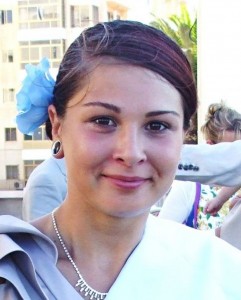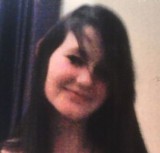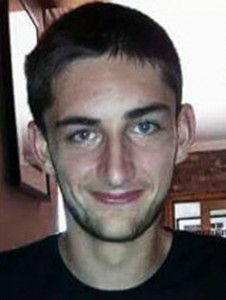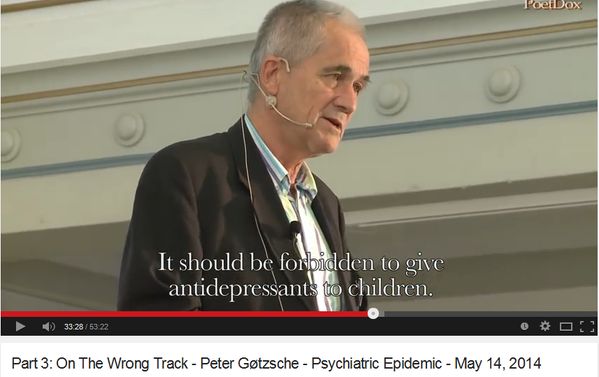Exactly one year ago I wrote an article called The Lost Children, in which I summarised several inquests that I had come across in 2014. In each of these it was reported that children had been prescribed antidepressants before taking their lives.
I also included other inquests where there was no specific report in the media of antidepressants being prescribed, although it seemed probable that psychiatric medication may well have had some involvement. What all these deaths had in common, however, was that in each case the child had been receiving treatment from medical professionals at or before the time of his or her death.
 By way of an introduction, I quoted in detail NICE Clinical Guideline 28 (right), which lays out three criteria, all of which must be met if antidepressants are to be prescribed to children under 18.
By way of an introduction, I quoted in detail NICE Clinical Guideline 28 (right), which lays out three criteria, all of which must be met if antidepressants are to be prescribed to children under 18.
These can be summarised as:
- Only if the antidepressant prescribed is Fluoxetine.
- Only if the child has been diagnosed with moderate to severe clinical depression.
- Only if it can be shown that the prescription has been preceded by at least 3 months of “specific interpersonal therapy” which has proved ineffective.
In other words, because of the risk of suicidal ideation, NICE regards the prescription of antidepressants to children as an absolute “last resort” option.
In August last year, I was contacted by a Human Rights organisation, asking permission to use The Lost Children as part of a submission to the United Nations Committee on the Rights of the Child in Geneva. It would seem that he CRC plan to discuss the medicating of children this year.
I have since added “2014” to the title of my original article, in preparation for summarising the following selection of reports of inquests in England and Wales in 2015 where children had been prescribed antidepressants before taking their lives:”
 Ashleigh Bowes was just 14 when she took a fatal overdose of “a drug used to treat anxiety” at her home in Cheshire in August 2014. In October 2015, an inquest heard that Ashleigh’s troubles began on the night of Halloween in 2013 when she had a ”meltdown” as she was about to go out. She told her mother that voices in her head were “telling her not to eat.” The following month, she was referred to the Priory by her GP for treatment for an eating disorder and depression. She attended the centre for regular therapy sessions and it was in February 2014 that she was first prescribed antidepressants. She was discharged from The Priory in August 2014 after a review. Two weeks later she wrote a note to friends who she said had teased her about her anorexia. She died later that night. Delivering a verdict of suicide, coroner Alan Moore said: “… I found nothing revealed by the investigation gives rise to concerns of a risk of other deaths in future.”
Ashleigh Bowes was just 14 when she took a fatal overdose of “a drug used to treat anxiety” at her home in Cheshire in August 2014. In October 2015, an inquest heard that Ashleigh’s troubles began on the night of Halloween in 2013 when she had a ”meltdown” as she was about to go out. She told her mother that voices in her head were “telling her not to eat.” The following month, she was referred to the Priory by her GP for treatment for an eating disorder and depression. She attended the centre for regular therapy sessions and it was in February 2014 that she was first prescribed antidepressants. She was discharged from The Priory in August 2014 after a review. Two weeks later she wrote a note to friends who she said had teased her about her anorexia. She died later that night. Delivering a verdict of suicide, coroner Alan Moore said: “… I found nothing revealed by the investigation gives rise to concerns of a risk of other deaths in future.”
 In November 2014, Jade Kosanlavit (15) ran in front of a train at Port Sunlight station on the Wirral. Six weeks before she died, Jade had taken an overdose of paracetamol. She was then prescribed Fluoxetine, which she took until her death. Jade’s uncle told the inquest in February that her family had concerns about the medication. He cited research which showed that Fluoxetine had an increased suicide risk of 64%, and added: “I think the whole family just find it difficult to understand that medication with this increased risk of suicide as an outcome is still being given in spite of this sort of evidence suggesting that children or adolescents can be pushed over the brink.” Even though Jade had not received the therapy laid down in the NICE Guidelines, coroner Andre Rebello nevertheless told Jade’s family that he was satisfied that medication was prescribed in accordance with what is expected. Mr Rebello recorded a verdict that Jade “took her own life while suffering from a depressive illness”, and came to this bizarre conclusion: “I can’t say that without medication, this wouldn’t have happened. What I can say is that it happened in spite of the medication.”
In November 2014, Jade Kosanlavit (15) ran in front of a train at Port Sunlight station on the Wirral. Six weeks before she died, Jade had taken an overdose of paracetamol. She was then prescribed Fluoxetine, which she took until her death. Jade’s uncle told the inquest in February that her family had concerns about the medication. He cited research which showed that Fluoxetine had an increased suicide risk of 64%, and added: “I think the whole family just find it difficult to understand that medication with this increased risk of suicide as an outcome is still being given in spite of this sort of evidence suggesting that children or adolescents can be pushed over the brink.” Even though Jade had not received the therapy laid down in the NICE Guidelines, coroner Andre Rebello nevertheless told Jade’s family that he was satisfied that medication was prescribed in accordance with what is expected. Mr Rebello recorded a verdict that Jade “took her own life while suffering from a depressive illness”, and came to this bizarre conclusion: “I can’t say that without medication, this wouldn’t have happened. What I can say is that it happened in spite of the medication.”
 The day before her death in April 2014, 16-year-old Aleysha McLoughlin from Bolton had been sent to hospital from school after cutting herself. The next day, she was found hanged in her bedroom by her foster-mother. At her inquest in March, it was reported by forensic pathologist Dr Charles Wilson that Aleysha had low levels of amphetamines and antidepressants in her body, and that “she might have experienced a comedown from the drug which enhanced her feelings of anxiety or depression.” His comment, of course, could have applied to either drug. Coroner Jennifer Leeming submitted a PFD Report, as she had concerns about Aleysha’s self-harming, but did not allude to her medication which may well have induced it.
The day before her death in April 2014, 16-year-old Aleysha McLoughlin from Bolton had been sent to hospital from school after cutting herself. The next day, she was found hanged in her bedroom by her foster-mother. At her inquest in March, it was reported by forensic pathologist Dr Charles Wilson that Aleysha had low levels of amphetamines and antidepressants in her body, and that “she might have experienced a comedown from the drug which enhanced her feelings of anxiety or depression.” His comment, of course, could have applied to either drug. Coroner Jennifer Leeming submitted a PFD Report, as she had concerns about Aleysha’s self-harming, but did not allude to her medication which may well have induced it.
 When “fun-loving, positive” 16-year-old student Courtney Towler was discovered dead in her bed at her Somerset home one morning in October 2014, her family assumed that she had died of natural causes. Her father said at the time: “One possibility is sudden teenage death syndrome, but we know she did not take her own life. She just passed away in her sleep.” At her inquest in February, however, it was revealed that Courtney had, in fact, taken a lethal overdose of Dothiepin. What was not reported at the time in the media was whether the antidepressant had been prescribed to her or had been obtained from another source.
When “fun-loving, positive” 16-year-old student Courtney Towler was discovered dead in her bed at her Somerset home one morning in October 2014, her family assumed that she had died of natural causes. Her father said at the time: “One possibility is sudden teenage death syndrome, but we know she did not take her own life. She just passed away in her sleep.” At her inquest in February, however, it was revealed that Courtney had, in fact, taken a lethal overdose of Dothiepin. What was not reported at the time in the media was whether the antidepressant had been prescribed to her or had been obtained from another source.
Immediately after the funeral of his mother in 2013, Paul Mullally (16) took an overdose of painkillers, and was hospitalised. He was then prescribed Fluoxetine by the local Child and Adolescent Mental Health Service (CAMHS) before he was discharged. In addition, Paul was prescribed Atomoxetine after he was diagnosed with ADHD a few months later. None of this was reported in the media after his inquest in July, but came to light in a Serious Case Review commissioned after Paul hanged himself in September 2014. He had been transferred from his foster-home to a children’s home in County Durham “to prepare for more independent adult living.”
 In October 2013, 17-year-old Alice Gibbs was admitted to the Beacon Centre in Edgware after her parents became concerned about her deteriorating mental health and the risk she posed to herself. By this time she had been taking antidepressants for several months. At her inquest in March, Alice’s parents condemned the Centre for “warehousing” their daughter. Her father Mike said: “On the Sunday when I visited, Alice was incredibly upset and, at that point, she was screaming that she was going to kill herself and so I went to see [a nurse] and explained Alice was threatening to kill herself and run off the first opportunity she got. She was not receiving any medication.” Nurses failed to pass on this vital information about Alice’s suicide threats. The omissions contributed to the decision not to place Alice under one-to-one observation, which would have prevented her from leaving the unit. When she did so, she carried out her threat to run to the nearest railway station, and she died after being struck by a train at Mill Hill Broadway. Coroner Andrew Walker recorded a narrative conclusion that her death was contributed to by neglect, but omitted to specify the additional neglect created by the failure to maintain a consistent dosage of Alice’s medication. Prescribing antidepressants to children is fraught with risks and, as the British National Formulary points out, the risk is exacerbated considerably if the dosage is changed.
In October 2013, 17-year-old Alice Gibbs was admitted to the Beacon Centre in Edgware after her parents became concerned about her deteriorating mental health and the risk she posed to herself. By this time she had been taking antidepressants for several months. At her inquest in March, Alice’s parents condemned the Centre for “warehousing” their daughter. Her father Mike said: “On the Sunday when I visited, Alice was incredibly upset and, at that point, she was screaming that she was going to kill herself and so I went to see [a nurse] and explained Alice was threatening to kill herself and run off the first opportunity she got. She was not receiving any medication.” Nurses failed to pass on this vital information about Alice’s suicide threats. The omissions contributed to the decision not to place Alice under one-to-one observation, which would have prevented her from leaving the unit. When she did so, she carried out her threat to run to the nearest railway station, and she died after being struck by a train at Mill Hill Broadway. Coroner Andrew Walker recorded a narrative conclusion that her death was contributed to by neglect, but omitted to specify the additional neglect created by the failure to maintain a consistent dosage of Alice’s medication. Prescribing antidepressants to children is fraught with risks and, as the British National Formulary points out, the risk is exacerbated considerably if the dosage is changed.
 17-year-old apprentice engineer Benn Sibbald found it difficult to cope with the grief that followed the death of his grandfather towards the end of 2014. He was referred to the local CAMHS in Kent, and was prescribed medication for depression. He began to hear voices, took an overdose, and cut his wrists. On three occasions, his mother Tracy approached the health service to ask if he could be admitted to hospital, but each time her request was denied. Instead, Benn met once a week with a clinical nurse specialist, until he reported feeling suicidal and was visited daily by different people from the Home Treatment Team. One evening in June last year, Benn, who had never behaved aggressively before, began smashing up the kitchen before running out of the house. The following morning he was found hanged in a nearby field. The coroner described Benn’s out-of-character behaviour as “inexplicable”, although it appeared to have been an example of SSRI-induced akathisia.
17-year-old apprentice engineer Benn Sibbald found it difficult to cope with the grief that followed the death of his grandfather towards the end of 2014. He was referred to the local CAMHS in Kent, and was prescribed medication for depression. He began to hear voices, took an overdose, and cut his wrists. On three occasions, his mother Tracy approached the health service to ask if he could be admitted to hospital, but each time her request was denied. Instead, Benn met once a week with a clinical nurse specialist, until he reported feeling suicidal and was visited daily by different people from the Home Treatment Team. One evening in June last year, Benn, who had never behaved aggressively before, began smashing up the kitchen before running out of the house. The following morning he was found hanged in a nearby field. The coroner described Benn’s out-of-character behaviour as “inexplicable”, although it appeared to have been an example of SSRI-induced akathisia.
 In June last year, 17-year-old Chantia Iruagha went missing from her Cardiff home. 10 days later her body was found in local woodland. An inquest concluded that Chantia had taken her life by carbon monoxide poisoning. 10 years previously, Chantia had been sexually abused by the man who was her step-father at the time, and who was subsequently sent to prison. In her teens, Chantia suffered domestic violence at the hands of two boyfriends, both of whom were convicted. Chantia was described as “an emotionally traumatised and extremely vulnerable teenager,” and had been prescribed antidepressants. Nowhere was it reported that Chantia had ever been diagnosed with moderate to severe depression.
In June last year, 17-year-old Chantia Iruagha went missing from her Cardiff home. 10 days later her body was found in local woodland. An inquest concluded that Chantia had taken her life by carbon monoxide poisoning. 10 years previously, Chantia had been sexually abused by the man who was her step-father at the time, and who was subsequently sent to prison. In her teens, Chantia suffered domestic violence at the hands of two boyfriends, both of whom were convicted. Chantia was described as “an emotionally traumatised and extremely vulnerable teenager,” and had been prescribed antidepressants. Nowhere was it reported that Chantia had ever been diagnosed with moderate to severe depression.
 In August 2014, 17-year-old Charlotte Cobbald took her life on her father’s farm in Suffolk by injecting herself with a drug used to treat animals. A Serious Case Review revealed that, in December 2012, Charlotte went to see her GP, who found her “sad and tearful,” and referred her to CAMHS. On her second appointment with CAMHS in February 2013, she was prescribed antidepressants. Cognitive Behaviour Therapy (CBT) was considered at this time to be a suitable future treatment option. At some point, Charlotte stopped taking antidepressants, but she resumed in January 2014 while she was in the care of the Priory, where she had been sent after it was noted that she had lost weight. It was here that Charlotte began to self-harm, and was sent to a high-dependency unit. After some improvement, she was allowed to go out on leave. No mention of the possible effects of her medication on her mental health was reported at her inquest.
In August 2014, 17-year-old Charlotte Cobbald took her life on her father’s farm in Suffolk by injecting herself with a drug used to treat animals. A Serious Case Review revealed that, in December 2012, Charlotte went to see her GP, who found her “sad and tearful,” and referred her to CAMHS. On her second appointment with CAMHS in February 2013, she was prescribed antidepressants. Cognitive Behaviour Therapy (CBT) was considered at this time to be a suitable future treatment option. At some point, Charlotte stopped taking antidepressants, but she resumed in January 2014 while she was in the care of the Priory, where she had been sent after it was noted that she had lost weight. It was here that Charlotte began to self-harm, and was sent to a high-dependency unit. After some improvement, she was allowed to go out on leave. No mention of the possible effects of her medication on her mental health was reported at her inquest.
 In July last year, 17-year-old sixth-form student Jay Cheshire was found hanging from a tree in Riverside Park, Southampton. His inquest in September heard that Jay was prescribed antidepressants for “low mood” in February and was set to undergo CBT. In March his state of mind was deemed to have improved and doctors said CBT was not “urgently” needed anymore. In May, Jay’s family contacted the centre once more saying that he was under pressure due to a ‘police matter’ and he was low again. It emerged at the inquest that Jay had been interviewed by the police about an allegation, which had in any case been withdrawn by the time of his appointment in June. Recording a verdict of suicide, coroner Grahame Short attributed Jay’s death to the allegation. He said about Jay: “I got the impression he was well liked and mature in some ways, but was a sensitive young man and vulnerable in some respects and he found it difficult to cope with the police investigation.” It would have been more accurate if the coroner had said that what Jay found difficult to cope with were the mind-altering drugs that he should never have been prescribed.
In July last year, 17-year-old sixth-form student Jay Cheshire was found hanging from a tree in Riverside Park, Southampton. His inquest in September heard that Jay was prescribed antidepressants for “low mood” in February and was set to undergo CBT. In March his state of mind was deemed to have improved and doctors said CBT was not “urgently” needed anymore. In May, Jay’s family contacted the centre once more saying that he was under pressure due to a ‘police matter’ and he was low again. It emerged at the inquest that Jay had been interviewed by the police about an allegation, which had in any case been withdrawn by the time of his appointment in June. Recording a verdict of suicide, coroner Grahame Short attributed Jay’s death to the allegation. He said about Jay: “I got the impression he was well liked and mature in some ways, but was a sensitive young man and vulnerable in some respects and he found it difficult to cope with the police investigation.” It would have been more accurate if the coroner had said that what Jay found difficult to cope with were the mind-altering drugs that he should never have been prescribed.
 17-year-old Kesia Leatherbarrow, described as intelligent and an extremely talented musician, was found hanged in a friend’s garden in December 2013, the day after spending 48 hours in custody in a Greater Manchester police station. She had been arrested after breaking a window of a residential care home, and was found to be in possession of a small quantity of cannabis. It was reported that Kesia had been kept in police cells despite becoming very distressed, banging her head against the wall and making threats to kill herself once she was released. During her time in custody, the police never completed a full risk assessment of her, she never received a mental health assessment and she was never seen by a doctor. The police did not contact her mother, health professionals or social services. She was seen only by two nurses from the Medacs Healthcare agency, neither of whom had mental health qualifications. Crucially, despite the fact that Kesia said that she was taking the SSRI antidepressant Sertraline, no efforts were made by police or nurses to obtain the medication for her while she was in custody. Stockport coroner Joanne Kearsley said that there had been missed opportunities for agencies to obtain and collate information, to carry out adequate assessments and to consider appropriate levels of support. In her 15-page PFD Report, however, she concluded that: “Despite these failings, there is not the evidence to say on the balance of probabilities any of these matters caused or contributed to her death.” What the coroner failed completely to address, however, was why on Earth anybody would think it appropriate to prescribe Sertraline to Kesia. Sertraline is linked inextricably with suicidal ideation, which is why it is not approved under any circumstances for children with depression. The fact that the dosage was not maintained throughout the period of Kesia’s custody increased the risk of suicide by a significant factor.
17-year-old Kesia Leatherbarrow, described as intelligent and an extremely talented musician, was found hanged in a friend’s garden in December 2013, the day after spending 48 hours in custody in a Greater Manchester police station. She had been arrested after breaking a window of a residential care home, and was found to be in possession of a small quantity of cannabis. It was reported that Kesia had been kept in police cells despite becoming very distressed, banging her head against the wall and making threats to kill herself once she was released. During her time in custody, the police never completed a full risk assessment of her, she never received a mental health assessment and she was never seen by a doctor. The police did not contact her mother, health professionals or social services. She was seen only by two nurses from the Medacs Healthcare agency, neither of whom had mental health qualifications. Crucially, despite the fact that Kesia said that she was taking the SSRI antidepressant Sertraline, no efforts were made by police or nurses to obtain the medication for her while she was in custody. Stockport coroner Joanne Kearsley said that there had been missed opportunities for agencies to obtain and collate information, to carry out adequate assessments and to consider appropriate levels of support. In her 15-page PFD Report, however, she concluded that: “Despite these failings, there is not the evidence to say on the balance of probabilities any of these matters caused or contributed to her death.” What the coroner failed completely to address, however, was why on Earth anybody would think it appropriate to prescribe Sertraline to Kesia. Sertraline is linked inextricably with suicidal ideation, which is why it is not approved under any circumstances for children with depression. The fact that the dosage was not maintained throughout the period of Kesia’s custody increased the risk of suicide by a significant factor.
 In her teenage years, Sara Green was a victim of bullying and began self-harming. She was referred to CAMHS in Grimsby, where she was admitted to a local hospital after taking an overdose of her antidepressants in July 2013. Because of a lack of available beds, Sara was placed in an adult ward before being transferred after a few days to the Priory Hospital in South Manchester, over 180 km from home. Sara was considered for discharge from the Priory in October 2013, but was still in the Unit 5 months later in March 2014 when, at the age of 17, she hanged herself in her room. Delivering a narrative verdict at the conclusion of the inquest in April, coroner Andrew Bridgman criticised the “inadequate provision” for children with mental health problems in Lincolnshire, and said that the failure of those responsible for her care at the Priory to organise her discharge “was a contributory factor to her act of self-harm.” The coroner also submitted a PFD Report, in which he criticised the record-keeping of practitioners at the Priory. He chose not to investigate the appropriateness or otherwise of her medication regime, something that was also ignored in the subsequent Serious Case Review.
In her teenage years, Sara Green was a victim of bullying and began self-harming. She was referred to CAMHS in Grimsby, where she was admitted to a local hospital after taking an overdose of her antidepressants in July 2013. Because of a lack of available beds, Sara was placed in an adult ward before being transferred after a few days to the Priory Hospital in South Manchester, over 180 km from home. Sara was considered for discharge from the Priory in October 2013, but was still in the Unit 5 months later in March 2014 when, at the age of 17, she hanged herself in her room. Delivering a narrative verdict at the conclusion of the inquest in April, coroner Andrew Bridgman criticised the “inadequate provision” for children with mental health problems in Lincolnshire, and said that the failure of those responsible for her care at the Priory to organise her discharge “was a contributory factor to her act of self-harm.” The coroner also submitted a PFD Report, in which he criticised the record-keeping of practitioners at the Priory. He chose not to investigate the appropriateness or otherwise of her medication regime, something that was also ignored in the subsequent Serious Case Review.
 When 17-year-old Sian Armstrong told her GP that she had been having problems in her relationship with her boyfriend and was not enjoying her time at college, she was diagnosed with depression and given medication. Sian then began self-harming and took an overdose of her medication in March 2014, after which she was referred to CAMHS, who in turn arranged for the mental health support charity Off The Record to provide CBT for her. However, between March and her death by hanging in June 2014, at the age of 17, Sian was never seen by the organisation, despite calling to make an appointment. Recording a narrative conclusion, coroner Maria Voisin voiced her concerns that there was a delay in Sian’s receiving CBT, and submitted a PFD Report to North Bristol NHS Trust. The coroner did not, however, query why medication was prescribed before therapy, a decision which was totally contrary to NICE Guidelines.
When 17-year-old Sian Armstrong told her GP that she had been having problems in her relationship with her boyfriend and was not enjoying her time at college, she was diagnosed with depression and given medication. Sian then began self-harming and took an overdose of her medication in March 2014, after which she was referred to CAMHS, who in turn arranged for the mental health support charity Off The Record to provide CBT for her. However, between March and her death by hanging in June 2014, at the age of 17, Sian was never seen by the organisation, despite calling to make an appointment. Recording a narrative conclusion, coroner Maria Voisin voiced her concerns that there was a delay in Sian’s receiving CBT, and submitted a PFD Report to North Bristol NHS Trust. The coroner did not, however, query why medication was prescribed before therapy, a decision which was totally contrary to NICE Guidelines.
In the reports of inquests summarised below, there is no prima facie evidence that antidepressants or any other form of psychiatric medication had been prescribed. In each case, however, the child had been receiving some form of treatment from medical professionals at or before the time of his or her death. In the majority of instances, at least part of the child’s treatment was delivered under the auspices of the Child and Adolescent Mental Health Service (CAMHS), which can be accessed via NHS local health authorities.
 An inquest in London in November heard that 13-year-old schoolgirl Francesca Candita-Simpkins, described as “academically gifted”, hanged herself at home six months earlier. During the course of the inquest, it was revealed that Francesca had “received on and off treatment for anxiety since 2008”, when she would have been just 6 or 7 years old. Francesca was “receiving treatment” from South London and Maudsley NHS Foundation Trust. She was prescribed Melatonin, a sedative which is linked to suicidal thoughts, particularly in females aged from 10 to 19 years. Recording a narrative verdict, coroner Lorna Tagliavini said: “… I don’t find that there was a causative or contributive factor by the mental health trust but there were some gaps in the care.”
An inquest in London in November heard that 13-year-old schoolgirl Francesca Candita-Simpkins, described as “academically gifted”, hanged herself at home six months earlier. During the course of the inquest, it was revealed that Francesca had “received on and off treatment for anxiety since 2008”, when she would have been just 6 or 7 years old. Francesca was “receiving treatment” from South London and Maudsley NHS Foundation Trust. She was prescribed Melatonin, a sedative which is linked to suicidal thoughts, particularly in females aged from 10 to 19 years. Recording a narrative verdict, coroner Lorna Tagliavini said: “… I don’t find that there was a causative or contributive factor by the mental health trust but there were some gaps in the care.”
 When 13-year-old Frankie Cushion was found unconscious in her bedroom in Liverpool in August last year, she was rushed to hospital but could not be resuscitated. Frankie had been taken to a doctor about behavioural concerns, but the doctor had suggested that her case was not urgent and that she was not a threat to herself. In the month before her death, Frankie’s mother took her to see a paediatrician, who had referred her to CAMHS for further assessment. Frankie’s mother told the inquest in November that she thought that Frankie had been trying to scare her parents rather than kill herself. Coroner Anita Bhardwaj said that she could not be sure “beyond reasonable doubt” that Frankie intended to take her life. Returning a verdict of accidental death, she said: ‘It is more likely than not that Frankie’s behaviour was part of a developmental disability.”
When 13-year-old Frankie Cushion was found unconscious in her bedroom in Liverpool in August last year, she was rushed to hospital but could not be resuscitated. Frankie had been taken to a doctor about behavioural concerns, but the doctor had suggested that her case was not urgent and that she was not a threat to herself. In the month before her death, Frankie’s mother took her to see a paediatrician, who had referred her to CAMHS for further assessment. Frankie’s mother told the inquest in November that she thought that Frankie had been trying to scare her parents rather than kill herself. Coroner Anita Bhardwaj said that she could not be sure “beyond reasonable doubt” that Frankie intended to take her life. Returning a verdict of accidental death, she said: ‘It is more likely than not that Frankie’s behaviour was part of a developmental disability.”
 14-year-old Sarah Clerkson was in foster care in Sunderland. In December 2013, she got drunk at a house party and fell asleep in a bedroom. An hour later, she was found hanged. At her inquest in May, Sarah was described as having had a “troubled past”, and had been exposed previously to drink and drugs. It was also reported that she had been subjected to online bullying, and her grandparents described her as “emotionally disturbed.”
14-year-old Sarah Clerkson was in foster care in Sunderland. In December 2013, she got drunk at a house party and fell asleep in a bedroom. An hour later, she was found hanged. At her inquest in May, Sarah was described as having had a “troubled past”, and had been exposed previously to drink and drugs. It was also reported that she had been subjected to online bullying, and her grandparents described her as “emotionally disturbed.”
 Sarah’s friend Danielle Formosa, also 14, had been known to children’s services in Sunderland since she was 6, and was abused by a paedophile months before her death. She hanged herself in her bedroom in December 2013, less than a month after Sarah died. Her inquest in June heard that Danielle had written “RIP Sarah” on her water bottle. A Serious Case Review by Sunderland Safeguarding Children Board into the circumstances that led to the deaths of Danielle and Sarah was completed before their inquests, but has not yet been published.
Sarah’s friend Danielle Formosa, also 14, had been known to children’s services in Sunderland since she was 6, and was abused by a paedophile months before her death. She hanged herself in her bedroom in December 2013, less than a month after Sarah died. Her inquest in June heard that Danielle had written “RIP Sarah” on her water bottle. A Serious Case Review by Sunderland Safeguarding Children Board into the circumstances that led to the deaths of Danielle and Sarah was completed before their inquests, but has not yet been published.
 14-year-old Seren Bernard hanged herself in April 2012. In June last year, more than 3 years later, an inquest in Milford Haven concluded with a verdict of suicide. The summary of a Serious Case Review published by Pembrokeshire Council in April 2014 revealed that Seren had been designated as a “looked-after” child and placed with foster-parents 4 months before her death. Although she was already being treated by the local CAMHS, no mention of medication appeared in the summary. The inquest highlighted several failures in communication between CAMHS and the local authority. However, coroner Paul Bennett said that, while there were communication problems between the agencies involved in her care, they ”did not in any way cause or act as a contributory factor in her death.”
14-year-old Seren Bernard hanged herself in April 2012. In June last year, more than 3 years later, an inquest in Milford Haven concluded with a verdict of suicide. The summary of a Serious Case Review published by Pembrokeshire Council in April 2014 revealed that Seren had been designated as a “looked-after” child and placed with foster-parents 4 months before her death. Although she was already being treated by the local CAMHS, no mention of medication appeared in the summary. The inquest highlighted several failures in communication between CAMHS and the local authority. However, coroner Paul Bennett said that, while there were communication problems between the agencies involved in her care, they ”did not in any way cause or act as a contributory factor in her death.”
 In June last year, 15-year-old Jess Farrow was found hanged in her home in Wiltshire. Described as an aspiring dancer, caring and much-loved by her family, Jess had been treated for “low moods”. She self-harmed and developed an eating disorder, after which she was referred to Marlborough House, the Swindon CAMHS, where she received help from doctors over several weeks. In the days before her death, Jess had referred to “a Pandora’s Box being opened in her head.” During her inquest in December, a number of questions were asked about the care she had received from CAMHS, but coroner Claire Balysz, delivering a verdict of suicide, decided that Jess had received the right support at the time.
In June last year, 15-year-old Jess Farrow was found hanged in her home in Wiltshire. Described as an aspiring dancer, caring and much-loved by her family, Jess had been treated for “low moods”. She self-harmed and developed an eating disorder, after which she was referred to Marlborough House, the Swindon CAMHS, where she received help from doctors over several weeks. In the days before her death, Jess had referred to “a Pandora’s Box being opened in her head.” During her inquest in December, a number of questions were asked about the care she had received from CAMHS, but coroner Claire Balysz, delivering a verdict of suicide, decided that Jess had received the right support at the time.
 When 15-year-old Laura Newlands died at home in Rhyl, North Wales in October 2011, a post-mortem examination revealed that she had taken an overdose of the antidepressant Trazodone, prescribed to her father. Her inquest in November last year heard that Laura had been treated by CAMHS, and that she had expressed suicidal thoughts to a number of professionals including school counsellors, doctors and social workers. Coroner John Gittins recorded a verdict of suicide, and stated his intention to submit a PFD Report.
When 15-year-old Laura Newlands died at home in Rhyl, North Wales in October 2011, a post-mortem examination revealed that she had taken an overdose of the antidepressant Trazodone, prescribed to her father. Her inquest in November last year heard that Laura had been treated by CAMHS, and that she had expressed suicidal thoughts to a number of professionals including school counsellors, doctors and social workers. Coroner John Gittins recorded a verdict of suicide, and stated his intention to submit a PFD Report.
 The boyfriend of 15-year-old Rebe Berry broke off their seven-month long relationship in December 2014, after which she sent him a several messages on social media, saying that she had decided to kill herself. She then she set herself on fire in the garden of her home in Dorset, and died of carbon monoxide poisoning. At her inquest in September, she was described by a counsellor as “isolated, lonely and depressed.” Her adoptive mother commented: “She had struggled throughout her adolescence with questions about her own identity and attachment disorder, as a result of being adopted.”
The boyfriend of 15-year-old Rebe Berry broke off their seven-month long relationship in December 2014, after which she sent him a several messages on social media, saying that she had decided to kill herself. She then she set herself on fire in the garden of her home in Dorset, and died of carbon monoxide poisoning. At her inquest in September, she was described by a counsellor as “isolated, lonely and depressed.” Her adoptive mother commented: “She had struggled throughout her adolescence with questions about her own identity and attachment disorder, as a result of being adopted.”
 An inquest in April was told that “star pupil” Elspeth McKendrick started attending CAMHS in Bury In 2011, but was upset the following year when doctors told her she had Asperger’s syndrome, a mild variation of autism. In August 2014, shortly after acquiring several top grades in her GCSE’s, the 16-year-old was found hanged in her bedroom after leaving a note on her laptop apologising to her family and telling how she wished she could open up to friends.
An inquest in April was told that “star pupil” Elspeth McKendrick started attending CAMHS in Bury In 2011, but was upset the following year when doctors told her she had Asperger’s syndrome, a mild variation of autism. In August 2014, shortly after acquiring several top grades in her GCSE’s, the 16-year-old was found hanged in her bedroom after leaving a note on her laptop apologising to her family and telling how she wished she could open up to friends.
 When 16-year-old Camborne schoolgirl Shannon Gee became upset by some entries on her Facebook page in September 2012, she took a fatal overdose of her mother’s alverine citrate tablets, usually prescribed for irritable bowel syndrome. At her inquest in January, Shannon’s parents suggested that she may have been bullied at school. She had been under the care of the local CAMHS, who described school as being “an outlet and the stability in Shannon’s life”. Coroner Andrew Cox delivered a verdict of accidental death.
When 16-year-old Camborne schoolgirl Shannon Gee became upset by some entries on her Facebook page in September 2012, she took a fatal overdose of her mother’s alverine citrate tablets, usually prescribed for irritable bowel syndrome. At her inquest in January, Shannon’s parents suggested that she may have been bullied at school. She had been under the care of the local CAMHS, who described school as being “an outlet and the stability in Shannon’s life”. Coroner Andrew Cox delivered a verdict of accidental death.
 An inquest in January heard that 17-year-old IT student Alessandro Ferro was grumbling about his college timetable as he watched TV with the family at home in Leyland the previous September, but did not seem at all depressed. The following morning, however, Alessandro was discovered to have hanged himself in his bedroom while under the influence of alcohol. He had been assessed by mental health professionals a month before his death.
An inquest in January heard that 17-year-old IT student Alessandro Ferro was grumbling about his college timetable as he watched TV with the family at home in Leyland the previous September, but did not seem at all depressed. The following morning, however, Alessandro was discovered to have hanged himself in his bedroom while under the influence of alcohol. He had been assessed by mental health professionals a month before his death.
 17-year-old Amy Ford had been placed in a children’s residential care home in Accrington due to a “complex personality disorder which led to her to self harm.” In May 2014, after an argument, Amy left the home and caught a train to Bamber Bridge, where she got off and walked into the path of a train travelling in the opposite direction. At her inquest in January, a psychiatrist said that she threatened “many times” to take her life, “but not act on it when she had a chance to be on her own.”
17-year-old Amy Ford had been placed in a children’s residential care home in Accrington due to a “complex personality disorder which led to her to self harm.” In May 2014, after an argument, Amy left the home and caught a train to Bamber Bridge, where she got off and walked into the path of a train travelling in the opposite direction. At her inquest in January, a psychiatrist said that she threatened “many times” to take her life, “but not act on it when she had a chance to be on her own.”
17-year-old Beth Wilkinson was described as a fun, caring teenage girl, who enjoyed looking after elderly people in her job as a carer. However, her inquest in Hull in September heard that she began self-harming when she was 13, and was referred to CAMHS. An ex-teacher said about her: “Sometimes she was buoyant, sometimes she was quite down. It varied week by week.” In December 2014, Beth jumped from the Humber Bridge. Coroner Paul Marks delivered a narrative verdict in which he stated that Beth “did not have a diagnosed psychological disorder.”
 It was said about 17-year-old student Harriet Walsh that she never got over the death of her grandmother in 2013. She was referred to CAMHS in Bolton, but was discharged two weeks before she hanged herself at home in April last year. At her inquest in June, Harriet’s mother described her as “a troubled girl who had issues with self-esteem.” On occasions, she would cut herself, and often told her mother that she felt “second best.” Delivering a verdict of suicide, coroner Michael Singleton said that Harriet “had issues that related to anger that she was unable to express and deal with properly despite the help she was given.”
It was said about 17-year-old student Harriet Walsh that she never got over the death of her grandmother in 2013. She was referred to CAMHS in Bolton, but was discharged two weeks before she hanged herself at home in April last year. At her inquest in June, Harriet’s mother described her as “a troubled girl who had issues with self-esteem.” On occasions, she would cut herself, and often told her mother that she felt “second best.” Delivering a verdict of suicide, coroner Michael Singleton said that Harriet “had issues that related to anger that she was unable to express and deal with properly despite the help she was given.”
 In October 2014, Sean Bailey (17) died at his home in Hull after taking an overdose of an unnamed medication. On Facebook, Sean told his friends that he had “had enough.” Earlier in the year, Sean told his doctor that he had been feeling depressed after the death of his grandmother. At his inquest in July, it was revealed that Sean had told a consultant psychologist a month before his death he had been feeling depressed since January but said he had no plans to kill himself. The psychologist had recommended one-to-one support and sent a letter to her manager to authorise the treatment, but by the time of his death nearly five weeks later, the letter had still not been read or sent out to implement the sessions.
In October 2014, Sean Bailey (17) died at his home in Hull after taking an overdose of an unnamed medication. On Facebook, Sean told his friends that he had “had enough.” Earlier in the year, Sean told his doctor that he had been feeling depressed after the death of his grandmother. At his inquest in July, it was revealed that Sean had told a consultant psychologist a month before his death he had been feeling depressed since January but said he had no plans to kill himself. The psychologist had recommended one-to-one support and sent a letter to her manager to authorise the treatment, but by the time of his death nearly five weeks later, the letter had still not been read or sent out to implement the sessions.
 According to his father, 17-year-old Tristan Powell had suffered with low-level depression for some time. He felt that he had no prospects, and was losing his friends. He began self-harming and attended A&E on a number of occasions. An inquest in February heard that Tristan was referred to Lime Trees, the outpatient section of York CAMHS, at the beginning of August 2014. Although his mood appeared to be improving, Tristan hanged himself at home before the end of the month.
According to his father, 17-year-old Tristan Powell had suffered with low-level depression for some time. He felt that he had no prospects, and was losing his friends. He began self-harming and attended A&E on a number of occasions. An inquest in February heard that Tristan was referred to Lime Trees, the outpatient section of York CAMHS, at the beginning of August 2014. Although his mood appeared to be improving, Tristan hanged himself at home before the end of the month.
 Some time about 9 o’clock on the evening of Friday 17th April last year, 17-year-old student Rachelle Owen left her house in Hoylake to go for a walk. Almost half-an-hour later, she stepped in front of a train. On the afternoon of Monday April 20th, less than 3 full days after her death, coroner Andre Rebello presided over Rachelle’s inquest. An account by the train driver was read out, and Mr Rebello delivered his verdict: “Rachelle walked out in front of an oncoming train … She sustained fatal multiple injuries. Given the evidence we have I am satisfied that Rachelle took her own life.” He added: “I prefer not to use the word suicide.” At the end of February, Rachelle had learned of the death of her mother, who had been found murdered in a Liverpool flat.
Some time about 9 o’clock on the evening of Friday 17th April last year, 17-year-old student Rachelle Owen left her house in Hoylake to go for a walk. Almost half-an-hour later, she stepped in front of a train. On the afternoon of Monday April 20th, less than 3 full days after her death, coroner Andre Rebello presided over Rachelle’s inquest. An account by the train driver was read out, and Mr Rebello delivered his verdict: “Rachelle walked out in front of an oncoming train … She sustained fatal multiple injuries. Given the evidence we have I am satisfied that Rachelle took her own life.” He added: “I prefer not to use the word suicide.” At the end of February, Rachelle had learned of the death of her mother, who had been found murdered in a Liverpool flat.
 It is difficult to understand why this highly unusual “instant” inquest should have been held, presumably without either toxicology findings or a medical report from Rachelle’s GP which may have at least thrown some light on Rachelle’s frame of mind at the time of her death. Two months previously, Mr Rebello (right) had shown appalling discourtesy to the grieving relatives of Jade Kosanlavit (see above), not to mention a complete lack of professionalism, when he made a clumsy attempt to cover up the part played by Fluoxetine in Jade’s death. Like Jade, Rachelle stepped in front of a train on the Wirral, less than 20 km away from where Jade had died. Is it possible that there were other similarities in the deaths of Jade and Rachelle that were never revealed?
It is difficult to understand why this highly unusual “instant” inquest should have been held, presumably without either toxicology findings or a medical report from Rachelle’s GP which may have at least thrown some light on Rachelle’s frame of mind at the time of her death. Two months previously, Mr Rebello (right) had shown appalling discourtesy to the grieving relatives of Jade Kosanlavit (see above), not to mention a complete lack of professionalism, when he made a clumsy attempt to cover up the part played by Fluoxetine in Jade’s death. Like Jade, Rachelle stepped in front of a train on the Wirral, less than 20 km away from where Jade had died. Is it possible that there were other similarities in the deaths of Jade and Rachelle that were never revealed?
 In August 2013, Taylor Smith hanged himself at home in Billingham. He was just 9 years old at the time. He suffered devastating brain injuries, leaving him in “a vegetative state”, and died in hospital 9 months later. Taylor had been diagnosed with ADHD in October 2011, and was first prescribed medication in January 2012. An inquest in June last year heard that Taylor’s mother had become concerned when his medication had been increased shortly before he hanged himself. Coroner Clare Bailey delivered a verdict of misadventure.
In August 2013, Taylor Smith hanged himself at home in Billingham. He was just 9 years old at the time. He suffered devastating brain injuries, leaving him in “a vegetative state”, and died in hospital 9 months later. Taylor had been diagnosed with ADHD in October 2011, and was first prescribed medication in January 2012. An inquest in June last year heard that Taylor’s mother had become concerned when his medication had been increased shortly before he hanged himself. Coroner Clare Bailey delivered a verdict of misadventure.
In a Serious Case Review which was published in 2014, Taylor was given the name “Gavin”. Within the 74 pages of the published overview, there are several references to Gavin’s medication but, for whatever reason, no mention is ever made of what drugs were actually prescribed to him. At the point where the dosage was increased, the SCR mentions a “medication regime”, suggesting that more than one type of medication may have been prescribed. “The parents expressed clear concern about the medication regime that Gavin was subject to. Gavin’s mother commented that Gavin’s medication level had been changed a couple of weeks before the incident which led to this review. She described that she had voiced concerns about the change, but had been told by the CAMHS health professional that Gavin would be monitored. She did not feel that he had been given clear guidance or help to manage Gavin.” The subsequent section states that “Gavin’s mother described that she had noticed some effects on Gavin when the medication dose was increased. Gavin had exhibited destructive and unsettled behaviour and had suffered mood swings.”
The Serious Case Review failed to acknowledge the most critical factor leading to Taylor’s hanging and subsequent death, namely the change in his demeanour that occurred after the increase in dosage of the unnamed drug(s) that formed his “medication regime”. A major objective of this “Safeguarding Children” review appears to have been to safeguard Pharma.
But this could also be true of the other inquests featured in this article, where in each instance there has been an intervention by at least one medical professional. If psychiatric medication is mentioned at all at an inquest, it is usually at the instigation of a bereaved relative.
One has to ask why coroners and other experienced professionals who should be familiar with NICE Guidelines seem content to see them flouted, sometimes to the ultimate cost to the children to whom medication is mis-prescribed.
Are there really people of influence in our Health Service and our Coronial System who consider that protecting the identity of psychiatric drugs should take precedence over protecting our children?
During 2015, inquests reported in the media also included those of: Isabel Richardson (12), Alex Paylor (13), Oliver Cavey (13), Ashdon Muirhead (14), Elizabeth Gresty (15), Josie Herniman (15), Morgan James-Falconer (15), Tom Savage (15), Toni Connell (15), Oscar Phillips (16), Dominic Lancaster (17), Halima Begum (17), Jack Wilson (17), Leia McLean (17) and Shaun Howcroft (17).
Other teenagers whose inquests in 2015 found that they had lost their lives after taking antidepressants included Ben Stollery, Ezgi Serce, George Cheese, Greg Revell, Jack Krajic, Jessica Monks, Luke Dadds, Samuel Gale, Veronica Romero-Lopez and Vicky Bailey (all 18-years-old), and Ben Bennett, Chandni Nignam, and Michael Carter (all 19)
Top image: Train Tracks by Bob Dylan
Dedicated to the memory of Jake McGill Lynch (1998-2013)
Related Articles:
The Lost Children (2014, 2016, 2017 & 2018)
Why we shouldn’t give Prozac to children
Dana’s Human Rights – and ours
Were these children given Prozac?
Jake, Aged 14 (Part One, Part Two & Part Three)


All I can say is:
1. The contents of this post are not anecdotal evidence at all, it is compelling evidence regarding a category of drugs which is widely known as “antidepressants”.
2. Data regarding the safety and effectiveness of psychiatric drugs in humans is still being withheld by the sponsors (e.g. pharmaceutical companies, universities, governmental and non-governmental agencies).
3. The evaluation processes by which drug regulatory agencies approved these active psychopharmacological principles is deeply concerning. First, it should be clarified that the FDA, EMA, and many more “regulators” across the planet (e.g., INVIMA – Colombia) are facilitators instead of regulators; the term “drug regulatory agencies” is a euphemism. Second, there are frequently many inconsistencies between the reports of drug “regulatory” agencies, publications, and public records of clinical trials.
4. Finally, ‘last but not least’ (I copy that phrase from a text of Peter), it is indeed very sad evidence, it is also extremely outraging. I’ll continue reading your blog.
5. One more thing, it is quite different when you actually see the faces of lost young lives due to antidepressants, this matter is not merely about “drug study data” and “adverse drug effects”, it is (agreeing with P.G.) indeed the result of shamelessness and unaccountable pharmaceutical companies behaving more like criminal organizations instead of sincere entrepreneurship’s devoted to improving the population wellness.
http://chaoticpharmacology.com/2016/01/04/the-lost-children-2015-antidepaware/